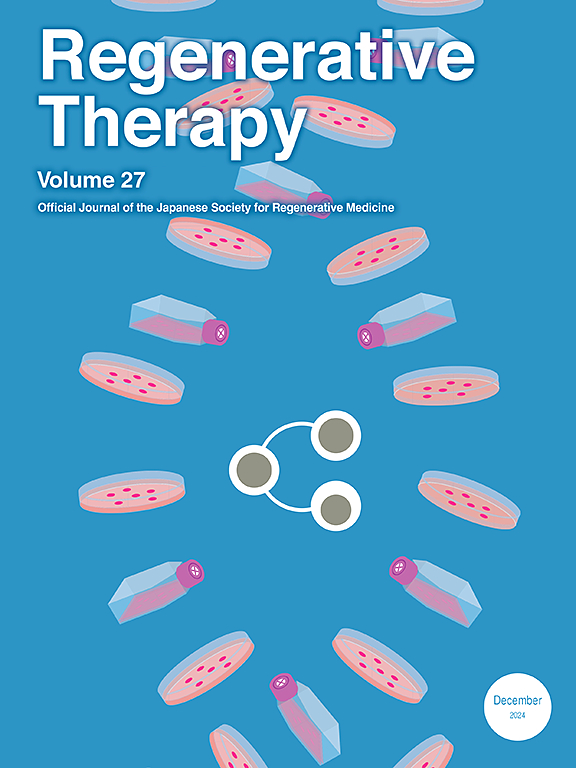Trehalose enhances neuronal differentiation with VEGF secretion in human iPSC-derived neural stem/progenitor cells
IF 3.5
3区 环境科学与生态学
Q3 CELL & TISSUE ENGINEERING
引用次数: 0
Abstract
Introduction
Cell transplantation therapy has emerged as a promising approach in regenerative medicine for treating neurological diseases. Neural stem/progenitor cell (NS/PC) transplantation has demonstrated therapeutic efficacy; however, its potential remains limited by suboptimal differentiation and insufficient secretion of pro-healing growth factors. Trehalose, a glucose disaccharide, has been shown to exert neuroprotective effects by inducing autophagy and stabilizing cellular structures. Recent studies suggest that trehalose can modulate growth factor secretion through the CDKN1A/p21 pathway. However, its impact on human induced pluripotent stem cell-derived NS/PCs (hiPSC-NS/PCs) remains unclear. This study investigates the effect of trehalose on neuronal differentiation, cell viability, and growth factor expression in hiPSC-NS/PCs to explore its potential in enhancing transplantation therapy.
Methods
hiPSC-NS/PCs were cultured as neurospheres and treated with trehalose (10 mg/ml or 40 mg/ml) for 7 days. Cell viability was assessed using CellTiter Glo® assay. Gene expression analysis was conducted via qRT-PCR and RNA-seq, particularly focusing on CDKN1A, VEGFA, FGF2, and BDNF. Protein expression of SOX2 was analyzed via western blotting. Neurite outgrowth was evaluated using MAP2 immunostaining following differentiation. Statistical significance was set at p < 0.05.
Results
Treatment with 10 mg/ml trehalose upregulated CDKN1A expression and promoted neuronal differentiation, as evidenced by reduced SOX2 expression and enhanced neurite outgrowth. RNA-seq analysis revealed the activation of growth factor-related pathways, including VEGFA upregulation, which persisted even after trehalose withdrawal (p = 0.016). However, high concentration (40 mg/ml) significantly reduced cell viability (p = 0.032), suggesting dose-dependent cytotoxicity.
Conclusion
Trehalose enhances neuronal differentiation and VEGFA secretion in hiPSC-NS/PCs, potentially augmenting the efficacy of transplantation therapy. These findings suggest that trehalose may serve as a valuable adjunct for neural regeneration, though optimal dosing must be determined to balance differentiation enhancement and cell viability. Further in vivo studies are warranted to validate its clinical applicability.
海藻糖通过VEGF分泌促进人ipsc衍生的神经干/祖细胞的神经元分化
细胞移植疗法已成为再生医学中治疗神经系统疾病的一种很有前途的方法。神经干细胞/祖细胞(NS/PC)移植已显示出治疗效果;然而,它的潜力仍然受到次优分化和促愈合生长因子分泌不足的限制。海藻糖是一种葡萄糖双糖,已被证明通过诱导自噬和稳定细胞结构来发挥神经保护作用。最近的研究表明海藻糖可以通过CDKN1A/p21途径调节生长因子的分泌。然而,其对人类诱导多能干细胞衍生的NS/PCs (hiPSC-NS/PCs)的影响尚不清楚。本研究探讨海藻糖对hiPSC-NS/PCs神经元分化、细胞活力和生长因子表达的影响,探讨海藻糖对移植治疗的促进作用。方法将shipsc - ns /PCs培养成神经球,用海藻糖(10 mg/ml或40 mg/ml)处理7 d。采用CellTiter Glo®法测定细胞活力。通过qRT-PCR和RNA-seq进行基因表达分析,重点关注CDKN1A、VEGFA、FGF2和BDNF。western blotting分析SOX2蛋白表达。分化后用MAP2免疫染色评估神经突生长情况。p <;0.05.结果10 mg/ml海藻糖可上调CDKN1A表达,促进神经元分化,SOX2表达降低,神经突生长增强。RNA-seq分析显示,生长因子相关通路的激活,包括VEGFA上调,即使在海藻糖停用后仍持续存在(p = 0.016)。然而,高浓度(40 mg/ml)显著降低细胞活力(p = 0.032),提示剂量依赖性细胞毒性。结论海藻糖可促进hiPSC-NS/PCs的神经元分化和VEGFA分泌,增强移植治疗的疗效。这些发现表明海藻糖可能作为神经再生的一种有价值的辅助剂,尽管必须确定最佳剂量以平衡分化增强和细胞活力。需要进一步的体内研究来验证其临床适用性。
本文章由计算机程序翻译,如有差异,请以英文原文为准。
求助全文
约1分钟内获得全文
求助全文
来源期刊

Regenerative Therapy
Engineering-Biomedical Engineering
CiteScore
6.00
自引率
2.30%
发文量
106
审稿时长
49 days
期刊介绍:
Regenerative Therapy is the official peer-reviewed online journal of the Japanese Society for Regenerative Medicine.
Regenerative Therapy is a multidisciplinary journal that publishes original articles and reviews of basic research, clinical translation, industrial development, and regulatory issues focusing on stem cell biology, tissue engineering, and regenerative medicine.
 求助内容:
求助内容: 应助结果提醒方式:
应助结果提醒方式:


